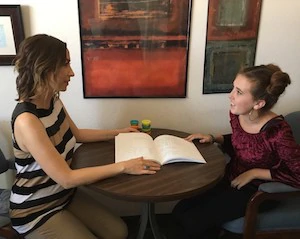Published 2018
Practice Self-Regulation™

"This program helped me in many ways. Not only educating myself more on how to make smart sexual decisions but how to emotionally deal with difficult things that were going on in life and using self-regulation. I loved all of the hands-on projects where I was able to draw and express my feelings through something I loved doing. I will truly miss doing this program."
- PS-R™ program participant
Program Description
Practice Self-Regulation (PS-R)™ is a therapeutic, trauma-informed intervention designed for youth affected by adverse child experiences. The intervention helps youth understand the impact of trauma on their sexual decision-making and learn about sexual health, with the aims of decreasing their risky sexual behavior and promoting their ability to regulate behavior. PS-R™, developed by Resources for Resolving Violence, is undergoing a rigorous evaluation by The Policy & Research Group to determine its effectiveness and contribute knowledge to the teen pregnancy prevention evidence base.
- Population: Youth (ages 14-19) who are receiving individual outpatient counseling services
- Locations: Eight cities across five states: Bakersfield, Fresno, and Oakland, CA; New Orleans, LA; Saco, ME; Adrian and Ann Arbor, MI; and Albuquerque, NM
- Partners: Outpatient clinics and independent licensed mental health clinicians
Goals
- Increase young people’s knowledge of sexual health and the impact of trauma on sexual decision-making
- Increase young people’s healthy sexual decision-making
- Increase young people’s self-regulation in all areas of their lives
Strategies
Therapy-education sessions
In 10 one-on-one sessions, each participant learns about sexual health from a licensed mental health clinician (facilitator) trained in PS-R™. During the sessions, participants and facilitators discuss the effects of trauma and the personal goals, beliefs, values, and choices that affect a person’s sexual health and well-being. They also review the workbook chapters participants completed (described below) and explore ways to apply lessons learned to daily life.
Workbook and fact sheets
Between sessions, participants answer questions in a workbook designed to help youth understand and apply effective strategies for self-regulation, sexual decision-making, healthy relationships, and personal safety. Additional fact sheets address topics such as: anatomy and physiology, puberty and adolescent development, identity, pregnancy and reproduction, and sexually transmitted diseases and HIV.
Multi-sensory activities
During the therapy-education sessions, facilitators lead participants through multi-sensory activities, which engage as many senses as possible to help participants understand and retain key concepts, practice skill-building, and improve decision-making. Activities included guided visualizations, art therapy, breathing exercises, and more. For example, in the “Personal Shield” activity, participants discuss the basic human need for self-protection with the facilitator and then create their own shields as a symbol of this need.
"[The program] made me realize that I can be strong and make good choices for the future. It made me realize my goals and want to make them come to life."
- PS-R™ program participant
Stats at a Glance
- 24.2 national teen birth rate (per 1,000 females ages 15-19) in 20141
- 7.8-39.2 range of 2014* teen birth rates (per 1,000 females ages 15-19) in the eight counties where PS-R™ operates; five are higher than the national average2,3,4,5,6
- 84 percent participants said their facilitators gave them tools to help regulate their emotions (2018)
- 84 percent participants plan to use information and skills learned about preventing STDs, HIV, and pregnancy (2018)
- 148 participants enrolled in PS-R™ from July 2016 through July 2018
* Reflects the most recent year for which data are available.
Grantee Information
Lynne Jenner
Director of Projects
504-865-1545
ljenner@policyandresearch.com
www.policyandresearch.com/
Print the full success story here.
About the TPP Program
The Office of Population Affairs (OPA) Teen Pregnancy Prevention (TPP) program is a federal grant program that funds diverse organizations working to prevent teen pregnancy across the United States. OPA invests in both the implementation of evidence-based programs and the development and evaluation of new and innovative approaches to prevent teen pregnancy. The OPA TPP program reaches adolescents ages 10-19, with a focus on populations with the greatest need in order to reduce disparities in teen pregnancy and birth rates.
Footnotes
1 Hamilton, B.E., Martin, J.A., Osterman, M.J., Curtin, S.C., & Matthews, T.J. (2015). Births: Final data for 2014. National Vital Statistics Report, 64(12). Hyattsville, MD: National Center for Health Statistics. https://www.cdc.gov/nchs/data/nvsr/nvsr64/nvsr64_12.pdf. back to top
2 California Department of Public Health, Maternal, Child and Adolescent Health Division. (2018). Adolescent birth rate (ABR) by county, females aged 15-19: California 2000, 2013, 2014 and 2015. https://www.cdph.ca.gov/Programs/CFH/DMCAH/CDPH%20Document%20Library/Data/Adolescent/ABR-Single-Yr-2013-2015.pdf. back to top
3 State of Louisiana, Office of the Governor. (2018). Teen births by parish. http://gov.louisiana.gov/page/teen-births-by-parish. back to top
4 Robert Wood Johnson Foundation, County Health Rankings and Roadmaps. (2018). Maine, teen births. http://www.countyhealthrankings.org/app/maine/2016/measure/factors/14/data. back to top
5 The Annie E. Casey Foundation, KIDS COUNT Data Center. (2018). Births to teens ages 15-19. https://datacenter.kidscount.org/data/tables/1642-births-to-teens-ages-15-19?loc=24&loct=5#detailed/5/3744-3826/false/573,869,36,868,867,133,38,35,18,17/any/13098,13108. back to top
6 The Annie E. Casey Foundation, KIDS COUNT Data Center. (2017). Teen birth rate, ages 15-19. https://datacenter.kidscount.org/data/tables/3843-teen-birth-rate-ages-15-19?loc=33&loct=2#detailed/5/4815-4847/false/870,869,868,573,36/any/17301,17800. back to top
 An official website of the United States government
An official website of the United States government
